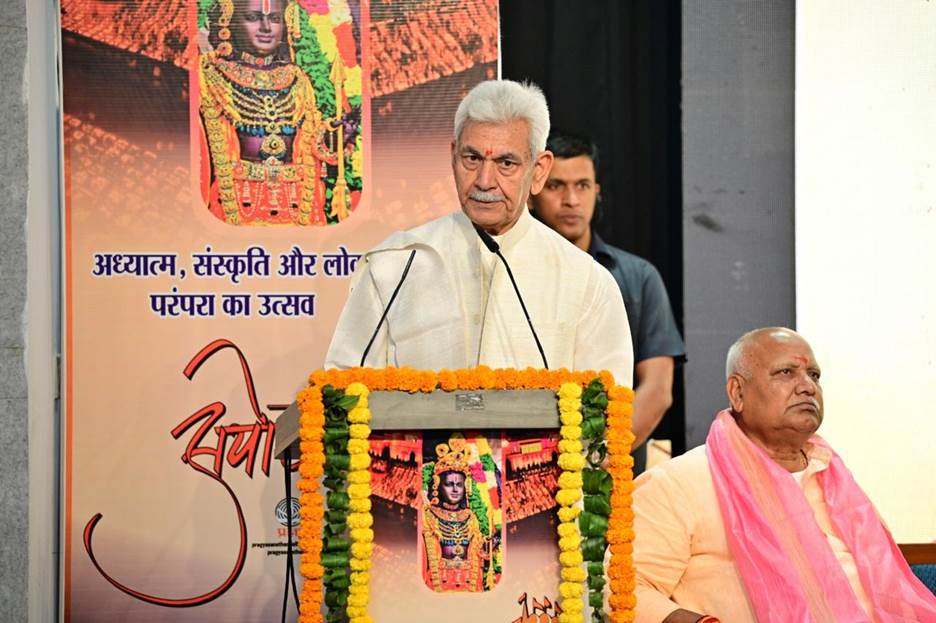Ayodhya Parv 2025 Unfolds in Delhi: A Grand Confluence of Culture, Faith & Art
Three-Day Cultural Festival at IGNCA Showcases Ayodhya's Spiritual and Artistic Legacy.

- Country:
- India
The Indira Gandhi National Centre for the Arts (IGNCA) has transformed into a vibrant epicenter of Indian culture and devotion with the commencement of the much-anticipated Ayodhya Parv 2025. The three-day cultural extravaganza, jointly organised by IGNCA and Shri Ayodhya Nyas, is a tribute to the spiritual, artistic, and philosophical grandeur of Ayodhya — the sacred city revered as the birthplace of Lord Ram.
The festival began with a ceremonial inauguration on April 11, marked by spiritual solemnity and cultural magnificence. Three distinguished exhibitions were unveiled, each offering a unique artistic lens on Ayodhya and Lord Ram’s enduring legacy.
Inaugural Exhibitions Illuminate the Spirit of Ayodhya
The first exhibition featured paintings by Padma Shri awardee Shri Vasudev Kamath, whose vibrant canvases captured the virtues and life episodes of Maryada Purushottam (Lord Ram). Alongside, an exquisite collection of Pahari miniature paintings based on the Valmiki Ramayana drew admiration for their intricate brushwork and historical significance. The third exhibition, Badi Hai Ayodhya, presented an immersive visual journey through the sacred geography of the Chaurasi Kos Ayodhya pilgrimage route, connecting viewers with the spiritual fabric of ancient Bharat.
These exhibitions were jointly inaugurated by a panel of esteemed dignitaries: Mahant Pujya Kamal Nayan Das Ji Maharaj of Mani Ram Das Chhawani, Ayodhya; Geeta Manishi Mahamandaleshwar Pujya Gyananand Ji Maharaj; Shri Manoj Sinha, Lieutenant Governor of Jammu & Kashmir; Shri Ram Bahadur Rai, President of IGNCA; and Shri Vasudev Kamath.
Cultural Leadership and Reverent Reflections
Following the inauguration, the guests shared profound insights into the cultural, historical, and spiritual relevance of Lord Ram and Ayodhya. Union Minister of Culture and Tourism Shri Gajendra Singh Shekhawat visited the exhibitions and praised the collaborative effort, stating, “Ayodhya is not just a city—it is a living symbol of India’s cultural soul. Lord Ram’s character continues to energize the moral and ethical compass of our nation.”
In his address, Shri Shekhawat emphasized the transformative power of devotional literature like Ramcharitmanas, authored by Goswami Tulsidas, in keeping Indian culture alive during periods of foreign invasions. “Tulsidas ji’s verses connected with the common heart, safeguarding the Sanatan spirit,” he said, adding that the consecration of the Ram Mandir in Ayodhya marks a new sunrise in India's civilizational journey.
Rhythmic Devotion and Musical Celebrations
The cultural proceedings commenced with a riveting Mridang performance by maestro Rajkumar Jha, accompanied by artists Vinod Vyas and Shri Pankaj. The atmosphere was further elevated by soulful bhajans and devotional songs by singers Pragya Pathak, Saket Sharan Mishra, and their ensembles, capturing the hearts of attendees.
Spiritual and Intellectual Discourse
Lieutenant Governor Shri Manoj Sinha eloquently described the significance of January 22—the day the reconstructed Shri Ram Janmabhoomi Mandir was inaugurated—as “not just a date, but a bridge between epochs.” He remarked, “Ayodhya is not merely a place on the map. It is a guiding force—our spiritual and cultural axis.” Addressing the youth, he described Lord Ram as a timeless symbol of justice, governance, and righteousness, and Ayodhya as a source of moral and national awakening.
IGNCA President Shri Ram Bahadur Rai provided an overview of Ayodhya Parv, underlining the importance of documenting Ayodhya’s legacy through books and publications. The book Chaurasi Kos ka Ayodhya, released during the event, highlights the pilgrimage circuit as a cosmic rather than merely geographic space. “The physical Ayodhya is 84 kos wide, but the spiritual Ayodhya is vast like the sky,” he said.
Pujya Gyananand Ji Maharaj highlighted India’s deep-rooted traditional values, describing the country as “a living thought.” Pujya Mahant Kamal Nayan Das Ji echoed the need for social harmony in knowledge traditions, challenging age-old discriminations and advocating inclusivity as central to Sanatan Dharma.
Day Two: Scholarly Dialogues and Classical Performances
April 12 opened with a compelling seminar on Temple Management in Indian Society, featuring voices from the saintly community of Ayodhya, as well as cultural and administrative experts. The discussions explored sustainable temple governance, preserving ancient practices while adapting to contemporary societal needs.
In the afternoon, scholars from across the country convened to deliberate on Goswami Tulsidas Ji’s Contribution to Innovations in Indian Culture. This intellectual exchange celebrated Tulsidas as both poet and philosopher, who transformed sacred narratives into tools for social upliftment and cultural continuity.
Evening festivities delighted audiences with classical dance and music. Richa Tripathi’s elegant Kathak and Bharatanatyam presentations, accompanied by tabla solos, provided a rich cultural spectacle.
Final Day: Literary Legacy and Grand Closure
On April 13, the final day, a symposium titled Shri Ram in the Essays of Kubernath Ray brought together notable Hindi scholars to examine the literary interpretations of Lord Ram in Ray’s essays. The session highlighted Ray’s role in integrating Ram-centric values into modern literary and philosophical discourse.
The festival concluded with an elaborate valedictory session graced by Pujya Govind Dev Giri Ji Maharaj, Treasurer of the Shri Ram Janmabhoomi Teerth Kshetra Trust; Shri Narendra Singh Tomar, Speaker of the Madhya Pradesh Legislative Assembly; IGNCA’s Shri Ram Bahadur Rai; Prof. Ramesh Chandra Gaur; and artist Shri Sunil Vishwakarma. The ceremony ended with traditional Alha singing by Faujdar Singh and folk melodies by celebrated singer Vijaya Bharti, closing the event on a harmonious and festive note.
A Vision for Cultural Revival
Ayodhya Parv 2025 stands as a beacon of cultural revival, reconnecting the contemporary Indian consciousness with its timeless roots in the Ramayana, the teachings of Tulsidas, and the soul of Ayodhya. Through exhibitions, discourses, art, music, and devotional celebration, the festival affirms that India’s civilizational journey continues to draw strength from its dharmic heritage.
As the sun sets on this three-day confluence, the message of Ayodhya—of righteousness, harmony, and spiritual grandeur—resonates more clearly than ever in the heart of the nation’s capital.
- READ MORE ON:
- Indira Gandhi National Centre for the Arts
- Ayodhya Nyas










